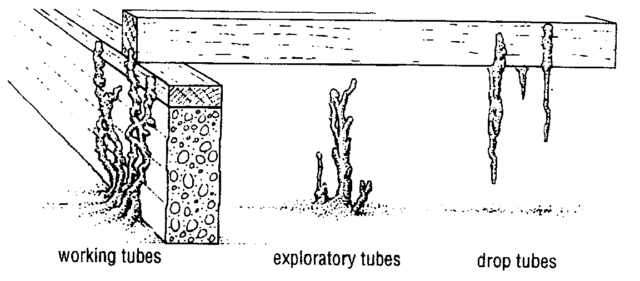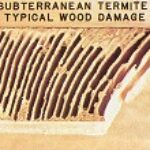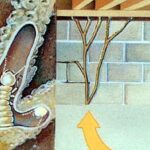Signs of Termite Infestation
Some of the following is taken from the NPCA Field Guide to Structural Pests, available through the NPCA (National Pest Control Association) Resource Center.
The following list indicates common signs of a subterranean termite infestation. It is recommended that you have your house thoroughly inspected by a pest control professional trained to detect the sometimes subtle signs of termites at least once a year.
- The presence of mud-like material that lines the galleries in an irregular pattern.
- Termites may excavate the wood so that only a very thin layer of wood is left on the surface of the cavity and the outside. Then this layer is broken; they will cover the holes with mud like material, used to make the tubes. This is a mixture of soil, feces, and saliva.
- Swarmers: The appearance of a swarm of what you would call “flying ants”,especially near light sources This indicates a nest may be near. A “swarm” is a group of adult male and female reproductive termitess that leave their nest to establish a new colony. Swarming occurs when a colony reaches a certain size. Swarming is most common in the spring (March, April, May, and June) and occasionally autumn (September and October).
- Most swarmers emerge during the day, most frequently on warm days after rain. Swarmers found outdoors near tree stumps, railroad ties, etc., are not an indication that your house is infested but are present on the outside only. On the other hand, finding swarmers indoors often means that you have a termite infestation within your house. At first glance, swarmers and ants look similar, but can be distinguished by certain physical features. At Differences between ants and termites, there is a picture and list of differences.
- Mud Tunnels: Subterranean termites maintain their headquarters in the ground and build “mud tubes”, pencil-size, that connect the nest (moisture) to the food source (wood).The tunnels may contain broken mud particles with fecal materials. Mud tubes or shelter tubes are proof of termite infestation, but their absence does not necessarily mean that a structure is free of termites. The insects may reach sills and other wood members through cracks or voids in the foundation wall, under the outside stucco, or from earth-filled porches, steps, terraces, or patios. You can break open tubes to determine if termites are still active inside. Termites often rebuild damaged tubes, another indication of continued activity. Old tubes are dry and will crumble easily.
- Subterranean termites construct four types of tubes or tunnels. Working tubes (left) are constructed from nests in the soil to wooden structures; they may travel up concrete or stone foundations. Exploratory and migratory tubes (center) arise from the soil but do not connect to wood structures. Drop tubes (right) extend from wooden structures back to the soil.

- Piles of wings: The shed wings of swarmers indicate termites have entered their next phase of development.
- Live termites: Reproductive kings and queens are 1/2″ long, winged and black or brown in color. Workers are sterile and usually hidden within infested wood. They are 1/4″ long, wingless and white. However, the absence of finding live termites does not mean that they are not present in the structure.
- Buckling paint or tiny holes on the wood.
- Damaged wood: Wood may appear crushed at structural bearing points. Termite damaged wood resonates with a dull thud (hollow sound)when tapped with a hammer. Pick and probe the surface of an infested piece of wood with a pen knife and you will find tunnels running parallel to the wood’s grain.
- Finding termites in a structure does not mean you have an immediate emergency because the rate at which damage occurs is relatively slow.
How to Inspect for Termite Activity
You will need a good flashlight, screwdriver or pocketknife and coveralls. Look at possible trouble spots closely. Often this means crawling in crawl spaces. The presence of swarmers or their shed wings almost always indicates termite activity. A complete termite inspection would mean locating exposed shelter tubes and damaged wood.
Generally speaking, Subterranean termites are found at or near ground level. However, in warmer areas of the country they occasionally occur above the first floor level.
Termite damage may be located by probing wood with a screwdriver, ice pick or knife. Inspection should be concerned with the exterior and interior surfaces of the foundation, particularly construction where wood is on or near the soil.
Start inspection in the basement and use a bright flashlight. Look for mud tubes and the activity of swarmers.
You should inspect in the following areas as well:
- Any wood construction in basement and crawl space (if present).
- All sills, sub floors, joists, support posts, supporting piers, basement window frames, wood under porches.
- Pay close attention to places where concrete: steps, porches, or slabs join the wooden structure.
- All the hollow blocks, cracks in cement or brick construction and expansion joints.
- Any scrap wood on the exterior, old tree stumps, fence posts and exterior frames of basement windows.
Note:
- If any of your findings are inconclusive, but you still worry that you may have termites, call a professional. Their training helps them know what to look for, and they can put your mind at ease.
- The first time you see a termite-like insect in your home, look at it thoroughly. Termites are often confused with ants.
- Before you jump into any treatment plan, it is a good idea to get a second opinion and thoroughly research companies you are considering hiring. Termites work slowly, and your house won’t be eaten to shreds if you take a couple days to figure out the best course of action.

